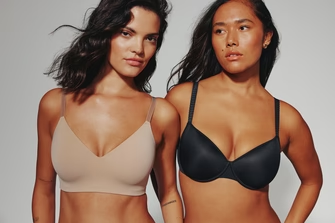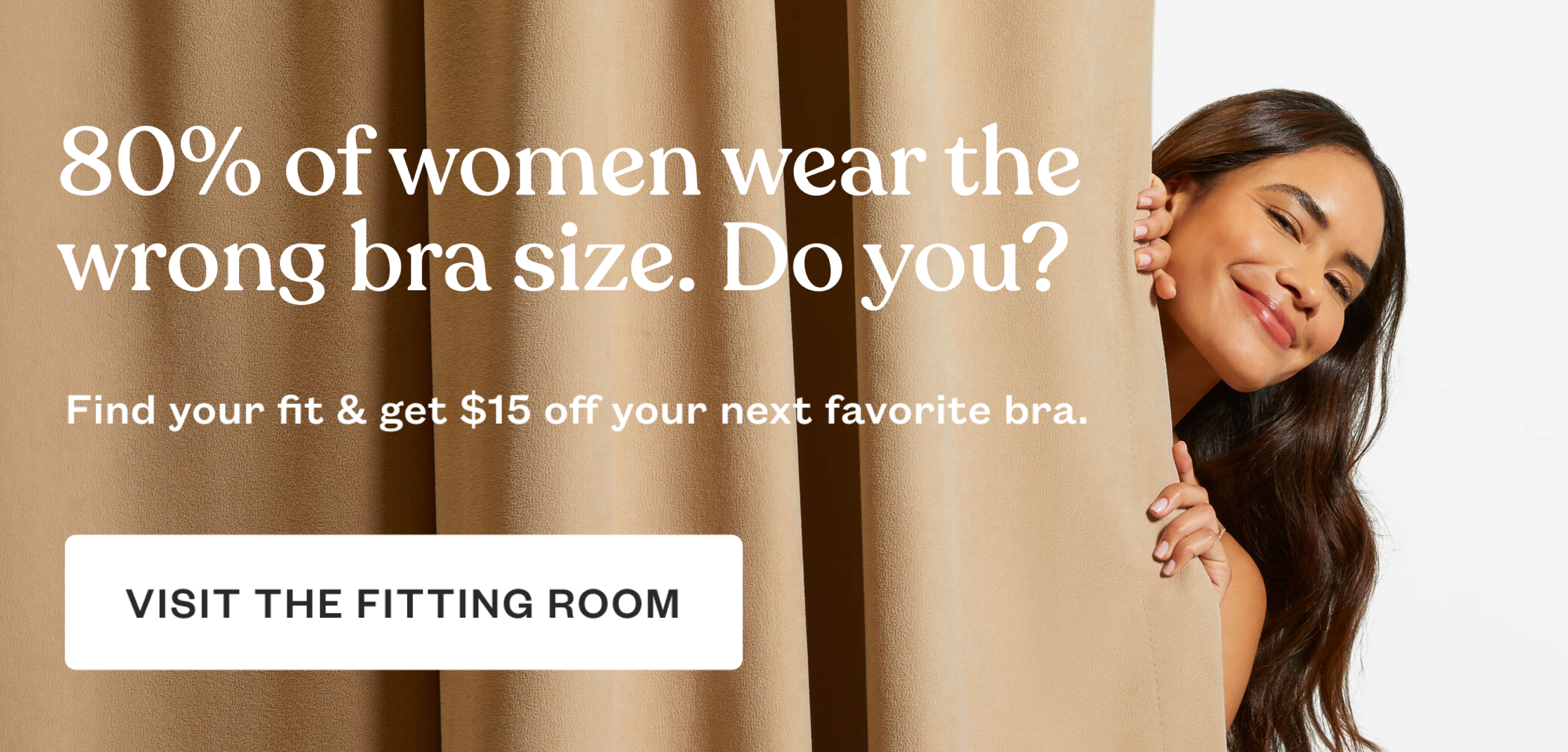Returns & exchanges free for 60 days for all U.S. orders. Please try on the bra to ensure a good fit, making sure to leave the original tags attached. We only accept underwear in unworn condition, with original tags, in its unopened original polybag. Items marked final sale are not eligible for return or exchange. If something’s not right, we can help. Our Fit Experts are available via live chat, or email to answer any questions you might have.
Read moreBra Sister Sizes: The Secret Every Woman Should Know

Shopping for clothes is generally a pretty straightforward experience. Sizes become larger as they advance, and that’s that. Bra sizes, on the other hand, are not quite as simple. You have to consider factors such as your unique breast shape, your band size, and your cup size — all of which rarely matches neatly with a single number and letter. This is where sister sizes come in – knowing this can help you find your perfect bra.
What Are Sister Sizes?
Sister sizes are groups of bra-size equivalents that are related by cup volume. For example, a 36F (DDD) cup belongs to the same family as a 38E, a 40D, and a 42C. Stick with us — we’ll explain.
Chances are, you learned somewhere along the line that you had a bra size and if it sort of fit, that was basically the end of the story. You may have also thought that unless one’s breasts actually changed size, there was just no way someone who was, for example, a B cup could also be a D cup. Wrong.
Bra sizes are more like ratios. The volume of a cup size (or how much breast tissue it can hold) varies with the band size. Let us break it down for you.
The Importance of Knowing Your Bra Sister Size
If you’ve ever struggled to measure your bra size and find a bra that fits your unique shape, you’re not alone. It’s no easy feat, and even less so when you’re unfamiliar with your sister sizes. Remember: it’s not you, it’s your bra. Identifying your sister size can be especially helpful if you find that neither your cup or band fit properly.
Benefits & Limitations of Sister Sizes
Sister bra sizes might feel like a revelation—one moment, you’re squeezing into a too-tight 34C, and the next, you’re comfortably lounging in a 36B like it’s made just for you. However, sister sizes have their boundaries.
On the upside, bra sister sizes allow for flexibility. They expand your options when shopping. If your bra size is unavailable, a quick glance at the bra sister size chart will save the day. Sister sizes are also handy for accommodating body changes.
However, sister sizes have limitations. They work best when moving only one size up or down; go too far, and the bra’s overall proportions can change.

What Does a Good-Fitted Bra Feel Like?
Ever wondered if you’re truly wearing the right bra, or have you just made peace with the discomfort? A good-fitted bra feels like your body’s best-kept secret–it’s there, but you barely notice it. The bra should support your breasts without feeling too tight or restrictive. The band should be snug, providing the most support. The cups should fully encapsulate your breasts without spillage or wrinkling. The bra should keep your breasts lifted and separated without straps that dig into your shoulders or slip off.
How to Find Your Bra Equivalent Sizes
So, how do you find your sister size? You can find your two closest sister sizes by (1) going up a band size and down a cup size, or (2) going down a band size and up a cup size. We promise It only sounds more complicated than it is, so we created a handy sister size calculator for you to reference.
Find your current bra size, and your sister sizes are the ones listed in the same row (going across). So, for example, if you’re a 34C, your sister sizes are 30E, 32D, 36B, and 38A. Each row is a family of sister sizes.

Let that sink in for a moment: an A cup can also be an E cup. Wild, right?
What’s amazing about sister sizes is that although they can be counterintuitive, they’re key to finding a great-fitting bra. For example, if you’re wearing a 34C and the cups fit, but the band is small, you might think “I’ll just go up a band size and try a 36C.” However, sizing up that way will likely result in cups that are too big because a 36C’s sister size is a 34D. The next sister size to a 34C is a 36B, which is the new size to try instead. The cups will still be the same size, but the band will be roomier.

Sister Size Bra Chart
Here’s a breakdown of what to do in a few specific scenarios! Follow along and take a look at our handy dandy sister size bra chart below to visualize going up and down band sizes and cup sizes for your specific size.
Your cups fit, but your band doesn’t: Adjust both your band and cup size in opposite directions. If your band is too small, go up a band size and down a cup size. If your band is too large, go down a band size and up a cup size.
Ex: A 34C cup is the same as a 36B. A 40E(DD) cup is the same as a 42D.

Your band fits, but your cups don’t: If the cups feel small, increase cup size. If the cups feel big, decrease cup size.
Ex. If the 32F feels small in the cups, go up to a 32G. If the 32F feels big in the cups, go down to a 32E.

Neither your cup or band fit: If both your band and your cup are too big, or if they are both too small, then adjust only your band size. Don't worry about changing your cup size - it'll naturally adjust with your band! If your band is too small and your cup is too big, then go up band sizes while reducing cup sizes, and vice versa. This solve is a bit trickier and will require you to try on more bras to find the perfect fit!
Ex: If a 32D is too small in both band and cup, try a 34D.

And sister sizes work with our signature half-cup sizes, too. If you’re a 34B½, you’re also a 36A½, and a 32C½. Because each of those sizes have equivalent cups, the bra you choose depends on which band size feels best to you. Now that you know about sister sizes, you’ll be equipped to choose bras that fit you more precisely.

Sister Size Up vs Sister Size Down
Bra sister sizes have the same cup volume, despite having different band sizes and cup letters. The terms sister size up and sister size down might appear perplexing, but it’s actually quite simple. Sister size up means the bra size is one band larger and one cup smaller than the one in reference. Conversely, sister size down is the opposite of that: one band size smaller and one cup size larger.
If your bra is fastened on the loosest clasp but still feels too constricting, contemplating your sister size up. It would mean moving one band size larger than your current bra and one letter down your current cup size. For example, if you are currently in a 34D bra size and the band feels snug, you can transition to the sister size up, which is 36C.
If your bra feels comfortably loose and is already on the tightest hook, you may need to try your sister size down. Go one band size down and one cup letter up. For example, if you wear a 36C and the band feels loose, consider trying a 34D. It should offer a more snug bra band while maintaining the same cup size.
Ideally, you should try to sister size up or down with the sister sizes immediate to your current size. Moving further could lead to excessively slack or overly constrictive band size.
Do Sister Sizes Actually Work?
Sister bra sizes are a great concept that proposes a perfect fit when your conventional bra size fails to work. But do they genuinely deliver the desired outcome? The simple answer is yes! Sister sizes work well as long as one does not exceed their limits. They can be especially useful when finding a better-fitting bra if your usual size is uncomfortable or unavailable. Bra sister sizes work on the fact that the cup volume is not fixed but relative to the band size. An increase in the band size has a corresponding slight increase in the cup size despite having the same letter. For example, a 34B and a 36B have different cup volumes even though both have B cups.
Sister sizing will work best when you are going one size up or down. Once beyond that threshold, the bra will change its overall proportion and either be ill-fitted or not provide enough support. It is also worth noting that they do not change the shape or position of your breast; they are only an adjustment of the band and cup size proportions to accommodate your breast optimally.
They may not be a magic solution, but bra sister size can be a helpful tool that facilitates your quest to find your ideal fit. Get professionally fitted, or try our Fitting Room Quiz to get your best bra recommendation.
Common Fit Concerns Women Have With Bras & Solutions
Many women experience common fit issues with bras. Here are some of the most frequent concerns and potential solutions.
Gapping cups: This occurs if the cups are too large. Try going down a cup size and see if that improves the fit. Alternatively, try a different style.
Spilling over the cups: go up a cup size or try a full-coverage style.
Band riding up: The band may be too loose; try a sister size bra with a smaller band.
Straps digging into your shoulders: Ensure that the band is carrying most of the weight and loosen the straps, or consider a bra with wider straps for better weight distribution.
80% of Women are Wearing the Wrong Bra Size
Did you know that 80% of women are wearing the wrong bra size? You deserve better. If you want some help finding your perfect fit, take our Fitting Room Quiz to find your bra size in just a few minutes, available in A-H, including half-cups!
Our goal at ThirdLove is to help women find their perfect fit, so don’t keep sister sizes a secret. Tell a friend, coworker, or—of course — your sister.
With additional reporting by Cathy Bishop and Nicole Yi.
Tags:

